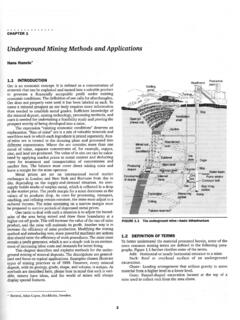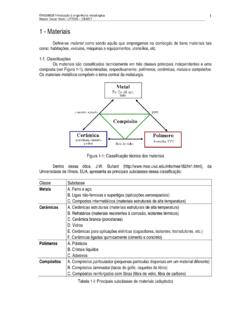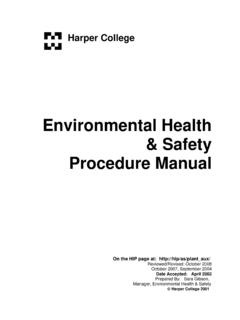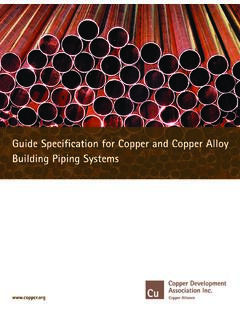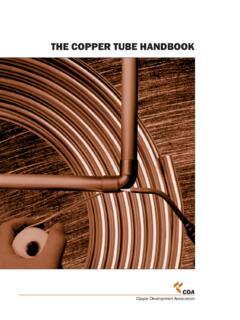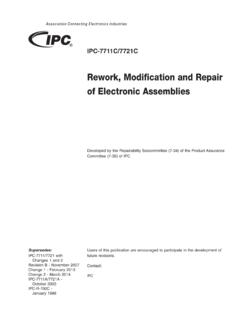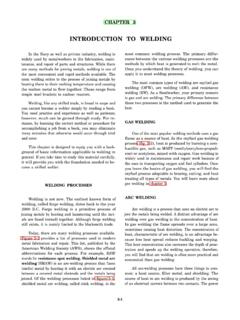Transcription of Electrorefining of Copper
1 Electrorefining of Copper 1. Electrorefining general Introduction In an Electrorefining process, the anode is the impure metal and the impurities must be lost during the passage of the metal from the anode to the cathode during electrolysis, the electrode reactions are, at the anode: M Mn+ + ne- and at the cathode: Mn+ + ne- M Electrorefining is a much more common process than electrowinning and such plants occur throughout the world on scales between 1000-100,000 ton/year. Usually they are part of a larger operation to separate and recover pure metals from both scrap and primary ores. Therefore, the process must be designed to handle a variable-quality metal feed and lead to a concentration of all the metals present in a form which can be treated further.
2 Electrorefining often provides a particularly high purity of metal. Electrorefining processes using a molten salt or non-aqueous electrolyte are used and, indeed, are the subject of further development. This is due to the possibilities they offer for increasing current densities and refining via lower oxidation states not stable in water ( refining of Copper via Cu+ would almost halve the energy requirement). However, aqueous processes presently predominate due to their ease of handling, more developed chemistry and familiarity with aqueous process liquors and electrolytes. Aqueous Electrorefining The conditions used for the refining of five metals are summarized in Table The electrolyte and other conditions must be selected so that both the anodic dissolution and the deposition of the metal occur with high efficiency while none of the impurity metals can transfer from the anode to the cathode.
3 Certainly there must be no passivation of the anode (cf. chapter 3) and the objective is to obtain a good-quality, often highly crystalline, deposit at the cathode. Where necessary, additives are added to the electrolyte to enforce the correct behavior at both electrodes. Chloride ion is a common addition to enhance the dissolution process and, where essential, organic additives are used to modify the cathode deposit. Since, however, organic compounds can be occluded to some extent and reduce the purity of the metal, their use is avoided when possible. Table Typical parameters for (aqueous) Electrorefining processes. 2. Copper Refining Copper uses The properties of Copper and its alloys that make it a major metal of commerce may be summarized as follows: high electrical conductivity; high thermal conductivity; ease of casting, extrusion, rolling, and drawing to produce wire, tubing, and strip; low corrosion rate of Copper when used for food preparation; excellent alloying characteristics; high esthetic appeal; and low toxicity to humans.
4 The occurrence of Copper in nature in the metallic form led to its use since early times either as metallic Copper , or alloyed with tin as bronze. It was used for tools, ornaments, pots for cooking, and coinage. Copper and brass, a Copper -zinc alloy, continue to have appeal as ornaments. The major use of Copper in modern times has been as an electrical conductor, and about 50% of the current demand is for electrical uses. Copper has a very high electrical conductivity per unit volume. It can be drawn readily into wires, either single or multifilament, which can be bent readily and repeatedly without excessive work hardening. Copper wire is readily tinned, has excellent soldering characteristics, and resists corrosion at contact points. Figure shows the flow of Copper from cathode through to Copper wire and the relative demand for the various wire types.
5 Figure Wire production from Copper cathodes. The resistance to salt water corrosion of admiralty brass, an alloy with 71% Copper , 28% zinc, and impurities, led to extensive use of this alloy in ships. This alloy has been largely replaced, in water applications with Copper -nickel alloys which consume thousands of metric tons of Copper annually. The resistance to corrosion of Copper by food and the nontoxicity of Copper in dilute concentrations has encouraged its use for food preparation equipment. Low corrosion rates coupled with ease of forming, bending, and of soldering resulted in extensive use of Copper tubing for domestic water pipe. Copper radiators for automobiles utilize the high thermal conductivity of Copper , and the ease of mechanical working and brazing.
6 Brass can be cast readily into intricate shapes and is used for many cast products having utilitarian or decorative applications. The ease of chrome plating brass has diversified the use of Copper alloys where appearance and resistance to corrosion are major requirements. Electrorefined Copper Fire-refined Copper is adequate for noncritical applications such as water tubing, bar stock, or ingots for alloying. Copper intended for electrical uses, however, is produced by Electrorefining or sometimes electrowinning techniques. Electrorefining process Virtually all Copper produced from ore receives an electrolytic treatment at some stage either via Electrorefining from impure anodes or electrowinning from leach or solvent-extraction liquors. Electrorefining produces the majority of cathode Copper ca. 95% as opposed to ca. 5% from electrowinning).
7 The Electrorefining step serves two purposes: 1) Elimination of unwanted impurities; cathode Copper typically has a purity > % wt Cu, with < % total metallic impurities; 2) Separation of valuable impurities which can be recovered in other processes. Figure shows a general flowsheet of the Copper refining operation. The major technical factors in Electrorefining are the cathode purity, the production rate and the specific energy consumption. These factors are influenced primarily by anode quality, electrolyte conditions and cathode current density. Figure Typical flow sheet for a Copper refinery. The process for Electrorefining Copper is typical of those carried out in aqueous solution. The electrolyte is Copper sulfate ( molar) and sulfuric acid (2 molar) and the way in which the purification of the Copper occurs can be seen by considering the metals likely to be found.
8 As impurities : 3) Ag, Au and Pt are more noble than Copper and therefore will not dissolve anodically. They will be found as metals in the anode slime; 4) Sn, Bi and Sb dissolve anodically but will precipitate in the electrolyte as oxide or hydroxide compounds which will be found in the anode slime; 5) Pb is oxidized anodically but will form insoluble lead sulfate in this electrolyte. Again, this will fall to the slime in the base of the cell; 6) Fe, Ni, Co and Zn all dissolve anodically and in the sulfate medium form species which are soluble in the electrolyte. The species formed, however, only reduce at potentials more negative than that at which the Copper deposits and therefore remain in the electrolyte. Hence, the impurities accumulate in either the electrolyte or the cell slime and these can be processed further to recover the significant metals (See Table below).
9 The electrolytic cells are generally of a very simple open-tank and parallel-plate electrode design, similar to that described above for Copper winning except that the anodes are now of the impure Copper (Figure ). The Copper anodes must have the correct size and geometry ( flat plates larger than the starter sheets of aluminum, titanium, steel, or thin Cu foil for the cathodes to avoid heavy edge deposits) and have a homogeneous composition. The flow rate of the electrolyte through the cells is low so that the slime drops to the base of the cell and does not come into contact with the cathode. Figure Diagram showing the structure of the cells in which the electrolytic refining of Copper is carried out. The anodes and cathodes are connected to the + and - current lines respectively. The elements which are more noble than Cu and the compounds are anodically insoluble and precipitate on the bottom of the cells beneath the anodes as anodic slimes or anodic sludge.
10 In the figure, the 'anodic sludges' are shaded, and some idea of the greater purity of the Copper cathode as compared with that of the anode is shown by the smaller density of spots on the cathodes. It should be added that, to reduce the effects of the ohmic drop, the anodes and cathodes are closer together than indicated in the figure. The electrolyte additionally contains organic additives which serve to control Copper electrocrystallization at the cathode (levellers and brighteners) and help prevent insoluble particulates from co-deposition (surfactants). Temperature is usually maintained via steam-heating at 60-65 C (inlet to cell), falling to 55-60 C (cell outlet). Circulation rates are typically m3/min, a cell achieving a nominal change of electrolyte every 4-6 h. This circulation helps to control temperature, gently increase the mass transport, prevent compositional gradients, replenish addition agents and serve as a convenient stream for bleeding-off impurities.
